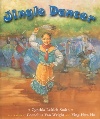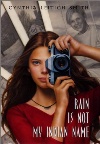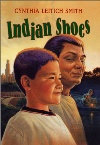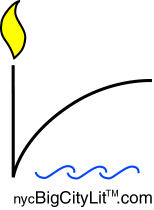Raised in Kansas City, Cynthia Leitich Smith has degrees in journalism and in law. She has lived abroad (Paris), and in Illinois (Chicago), Oklahoma, and Hawai'i. She and her writer husband, Greg Leitich Smith, now make their home in Austin, Texas.

Jingle Dancer (Morrow/Harper, 2000) is about Jenna, a young girl who longs to dance at the upcoming powwow of her Muscogee Creek-Ojibwe tribe. When time grows short and she can't get the tins needed to roll "jingles" for her dress, she turns to the women of her family and intertribal and mixed-race community. Their efforts save the day and Jenna dances. Written for ages 4 to 8, Jingle Dancer is beautifully illustrated by the watercolor team of Cornelius Van Wright and Ying-Hwa Hu.

Leitich Smith's highly-praised second book, Rain Is Not My Indian Name (Harper/Listening Library, 2001), finds a teen of mixed heritage devastated by the death of her friend. Again, her family and her tribal community help her mourn and heal.

Indian Shoes (Harper, 2002, illustrated by Jim Madsen) features Ray Halfmoon, a young Oklahoma boy orphaned when his parents die in a tornado and sent to live with Grampa in Chicago. Their story unfolds in a collection of deceptively simple tales of fishing, sports, and stars. Despite the generation missing between them (the boy's parents), and despite their own generation gap, grandfather and grandson find that a greater, deeper ancestral connection keeps the spirit of the past alive and keeps them going.
—AQ

June '02 [Home]
Interview
Children's Author, Cynthia Leitich Smith
by Alexis Quinlan
AQ: I loved Indian Shoes. Your subtle rendering of a Native American boy and his grandfather was wonderful.
CLS: Thank you. In writing, it goes back to the idea of subtlety. And if I say children need honesty from the grown-ups they love, I'm not saying that we should start drawing them diagrams or giving speeches. Each of us mourns in our own way, on our own timeline. Children feel no less deeply because of their youth, and they have the same range of emotions as adults. It's really the lack of life experience that differentiates the perspective of a child from an adult's. Sometimes, that lack of experience makes them more flexible, better able to see reality for what it is, without regard for societal burdens and expectations. They're a challenging audience and one to respect.
AQ: We forget how intelligent children are about loss. All kids are a little psychic, aren't they?
CLS: Children are tremendously observant. They have to be. So many of us grown-ups are busy trying to hide and protect them from what they already know to be true that oftentimes they're afraid to break it to us when something goes wrong. By trying to shield them so completely, we effectively leave them to fend for themselves.
AQ: I agree that you have to respect kids or they won't go beyond page one. You've said, "The only difference between children's and young adult literature as opposed to adult literature is the format and age of the protagonist." That seems a bit of a stretch to me. Can you defend that?
push their children from middle grade novels to adult ones.
CLS: It's most evident in young adult literature where length and marketing presentation often blur with those for books for grown-ups. Most of the fantasy/science fiction market, for example, could as easily be marketed as young adult niche as adult niche. Such books often feature characters under age twenty. What used to distinguish a young adult title from an adult title was the use of mature themes. Now, there are few such restrictions for the upper-level teen audience, although there is a heightened awareness of the emotional fallout of one's actions as well as of their consequences--not in a preachy way, but in a realistic one.
Some wonderful young adult titles that could have been as easily marketed as adult include: Burger Wuss by M.T. Anderson, Every Time a Rainbow Dies by Rita Williams-Garcia, Myrtle of Willendorf by Rebecca O'Connell, When Kambia Elaine Flew In From Neptune by Lori Aurelia Williams, and White Bread Competition by Jo Ann Yolanda Hernandez.
One of the biggest tragedies is when parents proudly push their children from middle grade novels to adult ones, skipping the young adult category. Worse, such young readers usually also have been encouraged to quickly abandon picture books for chapter ones. The theory is that it's somehow more important or impressive for their child to be associated with advanced-aged literature than for them to read and enjoy the stories that will most speak to them at a particular stage of life.
Yet what we're finding more and more in the Potter aftermath [Harry Potter series by J. Rollins, one recently made into a Hollywood film], is that adults have realized how much they enjoy children's books. We write first for children, but we also write for children within.
When confronted with someone who is dismissive of children's literature, I often ask about their favorite book as a child. Almost always, their expression lightens. They speak with great passion and, often, a heightened self-awareness of their own sensitivity and intelligence as a young reader. They explain why the book mattered, not only for its writing, its story, but for what was happening in their own lives. The magic lingers.
AQ: There are subcategories within children's books that include different ages of children on up to the YA, or young adult. Your three books have covered the range. Talk about writing for children versus for teens.
CLS: People are surprised to hear me say that it's actually more difficult to write for the youngest of those audiences. A novel is a marathon and a picture book is a sprint, but the shorter the project, the less malleable to revision. It has to be just the right idea going in. When you have thousands of words, a few clunkers will blend. When you have 850 or less, every one has to be perfect.
AQ. I love the image of the boy in Indian Shoes keeping a reading flashlight by his bed—and not only because I used to do that. What kind of a 10-year-old were you?
interest in me, it was a librarian.
CLS: I was fairly shy at ten, having just gone through a move and change of schools. It was the height of the off-the-rack, name-brand-display fashion trend, and my garage sale clothes just didn't stack up well against the Izod shirts and Gloria Vanderbilt jeans. Worse, I was a foot taller than everyone else and one of only three girls in the advanced placement classes. Then too, each year brought a different best friend, most lost through moves of their own.
I fantasized a lot, imagined myself as Princess Leia and Wonder Woman. My grandparents and great aunties were incredibly important. With them, issues like popularity or the 'do of the year seemed like the trivialities they really were.
I spent as much time as I could outside, yet I was a library kid too. My mother took me every Saturday morning to our local public library. I loved it and it was something we could afford to do. The first time anyone outside of my immediate circle showed a particular interest in me, it was a librarian. I've never forgotten that, or that books could be friends when the rest of the world somehow disappointed.
I read a lot of Newbery Award winners—those recognized by the American Library Association as most distinguished contributions to children's literature—mistakenly believing that the award logo was a corporate brand.
Like the majority of girls of my generation, I also read many books by Judy Blume, who was our most popular single-title trade author. It's probably her influence that has, in part, led to my concentration on contemporary, realistic stories as well as to my affection for the first person.
AQ. Tell us about quitting your day job to write full-time.
CLS: After law school, I found myself returning to children's literature, perhaps because all the "aforementioneds" and "heretowiths" were really grating on my nerves. I longed for sparse, poetic, melodic writing. Children's literature provided that and more.
Some of the best books I'd read as a child—From the Mixed-Up Files of Mrs. Basil E. Frankweiler by E.L. Konigsburg, The Witch of Blackbird Pond by Elizabeth George Speare, among others—were still treasures, but overall the bar hadn't just been raised, it had catapulted. This is the golden age of children's and young adult literature. Many of the best books today are written for kids and teens. The kid in me wanted to read all of it. And so, I began reading. Reading led to scribbling. Scribbling led to daydreams about doing something that mattered more. Books were precious to me, but "I want to be a writer" seemed about as realistic and responsible as "I want to be a rock star." I decided to become a journalist instead, and then went on to law.
I was working in the law office of the Department of Health and Human Services in Chicago when the Oklahoma City bombing occurred. I have close ties to Oklahoma. My tribe is there. I lived there when I was younger, and I still have family there. It was a reminder that our time in this world isn't limitless, that some dreams shouldn't wait.
AQ: I've been teaching creative writing to college students and we talk a fair amount about politics and art. How much politics can you put in and have it still be art? How much can you leave out and have the work be meaningful?
as it really, fictionally unfolds.
CLS: I don't fight it, and I don't try to force it in. My work to date has focused on Native American characters and themes. Like everyone, we're affected by politics, possibly more affected because we're legally citizens of both tribe and country. I've been urged to be more political, to be less political, or to be political in a way that appeals to mainstream liberals rather than Indians.
People have read things into my work that are simply baffling to me. Ultimately, I have to shrug it off. No single agenda is simpatico with life as it really, fictionally unfolds. My primary duty is to my characters and my young readers. To them, I owe truth as the fictional folks see it, even when it makes me uncomfortable. The Creator only knows how many children Judy Blume saved by caring enough about us to be candid about real life.
AQ: What writers are most important to you now?
by caring enough about us to be candid.
CLS: Favorite picture book writers include Carolyn Crimi and Sharon Darrow as well as Janie Bynum, Anna Grossnickle Hines, and Allen Say, who are also illustrators. Favorite novelists include Joan Bauer, Margaret Peterson Haddix, Kimberly Willis Holt, Annette Curtis Klause, Martha Moore, Ruth Pennebaker, and Carol Lynch Williams, among others.
AQ: Is this indeed the "golden age" of children's literature?
CLS: There are less than half as many outlets for writers to shop their manuscripts as there were during the boom of the 1980s. That sort of narrowing of the market has resulted in more competition and higher quality overall. It's not unusual for a publishing company to receive six thousand or more manuscripts annually and publish only one or two new voices. We still have our clunkers, of course, but generally the standards have risen—not steadily, but in surges.
AQ: Your web site, Cynthia Leitich Smith Children's Literature Resources, (cynthialeitichsmith.com.) has won many awards, including Writer's Digest's Top Ten Sites. Did you do it with help from your publishers or all on your own?
CLS: The web site is all my baby: If I'd known how big it was going to get, I might never have started! It's my way of sending out the message every day, world wide, that quality children's books do matter. It also provides real, easy-to-access information about what's available out there and how to find out more.
One can get discouraged about the industry, cutbacks to libraries, buy-outs [of independents], that sort of thing. Most literary trade writers do. I update almost daily, but the real work was in the original construction.
AQ: What sort of results do you get from having the site up and running?
and I'm a writer, not an academic.
CLS: The site has generated a lot of traffic and attention, but it is a personal site. I'm just me, not some major institution, and I'm a writer, not an academic. That creates a certain feel. For teachers and librarians, it's a professional resource. For writers, it's an industry resource. For readers, it's a great place to find out about new titles and the people who create them.
I've made a special effort to provide pages of interest to the communities with which I'm most familiar: interracial families, Native Americans, Asian Americans. I also highlight many of the types of books I most enjoy: contemporary fantasy, fantasy, horror, science fiction, historical picture books. I receive many personal requests for assistance, especially from families from underrepresented groups looking for titles that reflect their children's experiences and perspectives.
Of course, it also raises awareness of my own work and provides an opportunity for me to speak on related topics of interest, to be an advocate of sorts for quality books.
AQ: You've said that the children you write for you give you hope in return.
CLS: I receive notes from young readers. In the past year, I've heard from children who are working through loss. I've heard from many young Native readers gratified to see books about Indians that actually make sense to them.
I also interact personally, face-to-face, with kids. My favorite kind of event to do is a young writers' conference where I work with children and teens on their own stories.
AQ: The creation of the "child consumer" market is a pretty depressing fact of our times. Who are your most admired contemporaries?
when it was most difficult and resistance was highest.
CLS: Some of the folks who were writing for kids when I was one are still active producing quality work, including many of the multicultural pioneers, like Julius Lester, Joseph Bruchac, Allen Say, Walter Dean Myers, and Laurence Yep. Virginia Hamilton died early this year; what a loss. I had the opportunity to meet Nancy Garden [Annie on My Mind] last year and to interview her for my web site. She was really the first well-known writer focusing on gay and lesbian characters and themes in books for children.
It may be that I admire them so because these people broke through with their diverse voices at a time when it was most difficult and resistance was highest, but each is also a writer whose work stands strong on its own, separate from that dynamic.
AQ: You've become an important member of the children's literature community. In what senses is there a community? And how has that unfolded for you?
CLS: Mentoring and teaching are very commonplace in children's literature. Authors Kathi Appelt and Jane Kurtz took me under their wing. This extended not only to helping with my actual writing but also in passing on insights to the children's publishing industry. I'm mentoring two beginning writers now, offering as much in the way of encouragement as information.
The community comes together through professional organizations like the Society of Children's Book Writers and Illustrators, at conferences (both writing and, say, teacher- or library-oriented), via critique groups, and online. I've had the opportunity to correspond with many of the best folks writing today by virtue of a strong Internet presence.
AQ: What would you say to people writing for children?
CLS: I congratulate them on doing something that matters, that's difficult, that will make them stretch themselves. I'm realistic. One of the best writers I know took fifteen years to sell her first book. So, I encourage them to keep their day jobs (though I didn't). But mostly, I tell them to write for the child inside themselves, to be honest, to realize that the difficult questions in life often lend themselves to the most interesting stories.
I also tell them that the world has enough Love-Yourself, Love-Your-Mommy books.
(Alexis Quinlan is a freelance writer living in Lower Manhattan and also teaches creative writing at William Paterson College in New Jersey.)
[Part Two of this interview will appear in the July issue.]